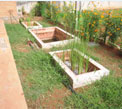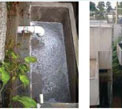Grey Water Treatment
Household waste water can be classified as follows:
- Black water: (containing urine and faeces) usually from the toilet
- Grey water: All other household waste water, essentially from the kitchen sink, clothes wash area , bathroom and other taps.
Waste water can be “recycled” which means it is purified and reused.
But even before that it can be “cycled” or reused which means that the same water can be used for multiple activities before it is allowed to flow down the drain.
Water cycling
Given below are two examples of water cycling. Use your imagination to figure out other ways to “cycle” household water!
- Using washing machine water for toilet flushing. If we look at the water consumption of an individual, we find that about 40% of the daily water demand is for toilet flushing. This means that if the other 60% is adequately captured, it will suffice for toilet flushing and there will still be some water left over for gardening.
- Using bath water for gardening: Bath water has a negligible amount of soap and can safely be used for watering plants and trees. Using organic soaps will further help the cause.
Water recycling
Reed bed or planted filter: The waste water is passed through a sand bed which contains plant species such as bamboo, canna and reeds. The roots of these plants utilize the nutrients present in waste water thus reducing the BOD (biological oxygen demand) and COD (chemical oxygen demand). The sand bed further purifies the water and the end result is clear filtered water.
The obvious advantages of such a system are:
- No power consumption
- Low maintenance
- Aesthetically appealing: It can be incorporated as part of the garden.


